P(2-py)3M(CO)n(NO+)3-n
| IE (eV) | |
| Cr | 6.766 |
| Mo | 7.099 |
| W | 7.98 |
| NO | 9.264 |
P(2-py)3Cr(CO)3
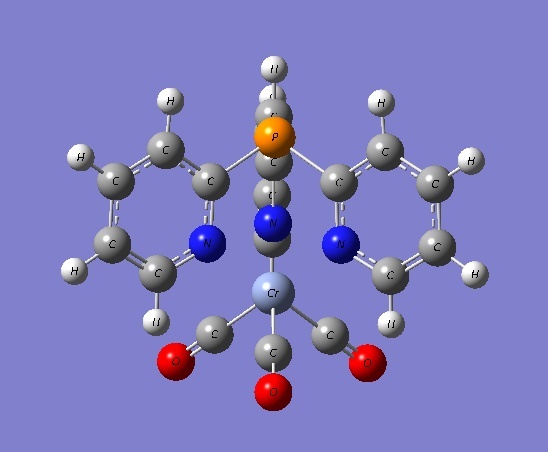
Structure
The singlet has C3V symmetry, and the triplet has a bent Cr-C-O and has Cs
symmetry.
| B3LYP/3-21G* | B3LYP/6-31G* | B3LYP/3-21G* | B3LYP/6-31G* | |
| singlet | singlet | triplet | triplet | |
| E(a.u.) | -2456.4004277 | -2468.8988274 | -2456.3627013 | -2468.8524291 |
| S-T gap | 23.7 kcal/mol | 29.1 kcal/mol | ||
| P-C | 1.827 | 1.849 | ||
| N-Cr | 2.094 | 2.160 | ||
| Cr-C | 1.806 | 1.835 | ||
| C-O | 1.185 | 1.170 |
Excited-State Energies (nm) and Oscillator Strengths
| TD B3LYP/3-21G* | TD B3LYP/6-31G* | |||
| 1 | 762.8 (2) | 0.024 | 713.0 (2) | 0.022 |
| 2 | 536.2 (2) | 0.062 | 519.2 | 0.155 |
| 3 | 506.4 | 0.084 | 516.5 (2) | 0.043 |
| 4 | 505.7 (2) | 0.014 | 491.4 (2) | 0.010 |
| 5 | 495.6 | 0.110 | 399.3 (2) | 0.006 |
| 6 | 404.7 (2) | 0.011 | ||
| 7 | 358.8 | 0.004 | ||
| 8 | 352.1 (2) | 0.008 | ||
| 9 | 335.9 (2) | 0.004 | ||
| 10 | 325.2 (2) | 0.013 |
B3LYP/3-21G*
Excited State 2: Singlet-?Sym 1.6254 eV 762.78 nm f=0.0242
101 ->103 0.48789
101 ->105 -0.14381
102 ->104 0.48784
Excited state symmetry could not be determined.
Excited State 3: Singlet-?Sym 1.6254 eV 762.78 nm f=0.0242
101 ->104 0.48825
102 ->103 -0.48749
102 ->105 -0.14382
Excited State 6: Singlet-E 2.3121 eV 536.24 nm f=0.0624
101 ->106 -0.11975
102 ->105 0.65123
102 ->107 -0.11988
Excited State 7: Singlet-E 2.3122 eV 536.23 nm f=0.0624
101 ->105 0.65122
101 ->107 0.11976
102 ->106 -0.11987
Excited State 10: Singlet-?Sym 2.4483 eV 506.41 nm f=0.0838
101 ->103 -0.26969
101 ->107 0.36270
102 ->104 0.26981
102 ->106 0.36344
Excited State 11: Singlet-?Sym 2.4520 eV 505.65 nm f=0.0139
101 ->105 -0.14613
101 ->107 0.48180
102 ->106 -0.48142
Excited State 12: Singlet-?Sym 2.4520 eV 505.65 nm f=0.0140
101 ->106 0.48194
102 ->105 0.14613
102 ->107 0.48128
Excited State 13: Singlet-?Sym 2.5018 eV 495.59 nm f=0.1101
101 ->103 -0.29512
101 ->107 -0.33178
102 ->104 0.29518
102 ->106 -0.33147
The band at 536 nm is apparently a metal (d) --> ligand (pyridine pi*) transition.
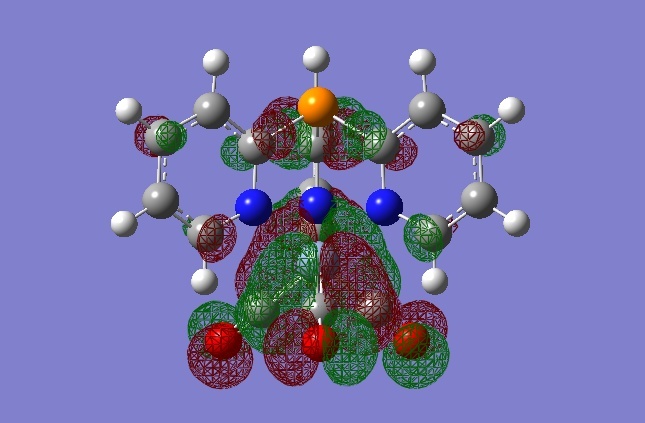

MO 103 MO 104

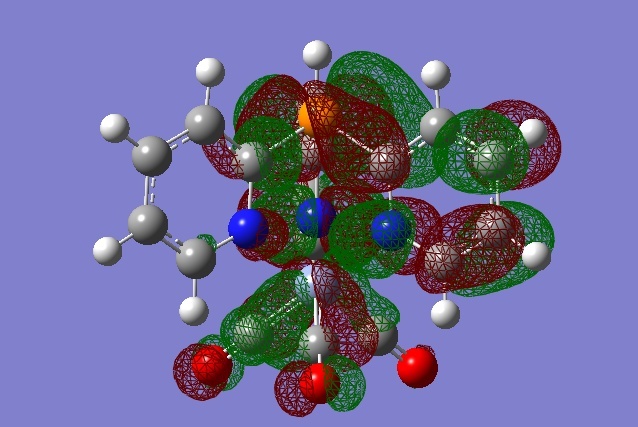
MO 105 MO 106
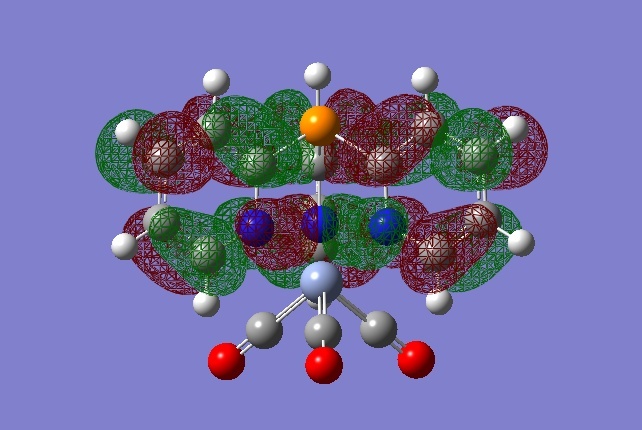
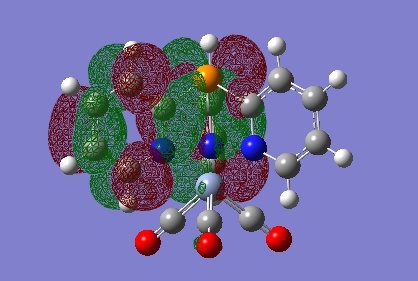
MO 107
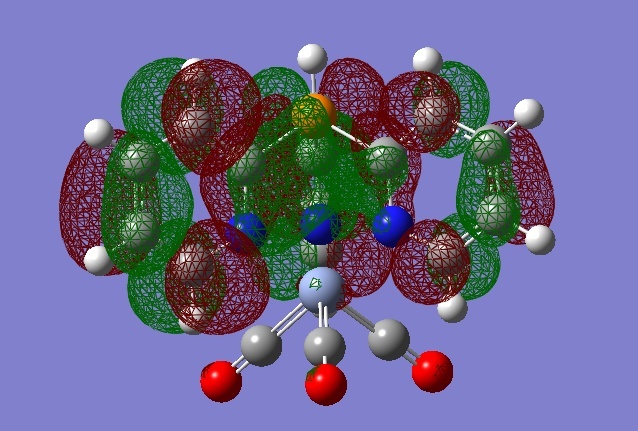
B3LYP/6-31G*
Excited State 2: Singlet-?Sym 1.7390 eV 712.97 nm f=0.0221
101 ->104 -0.49340
102 ->103 0.49354
102 ->105 0.10341
Excited State 3: Singlet-?Sym 1.7390 eV 712.96 nm f=0.0221
101 ->103 0.49283
101 ->105 -0.10342
102 ->104 0.49411
Excited State 6: Singlet-?Sym 2.3879 eV 519.22 nm f=0.1547
101 ->104 0.42365
102 ->103 0.42350
Excited State 7: Singlet-E 2.4003 eV 516.54 nm f=0.0434
101 ->105 0.66919
101 ->107 -0.10674
102 ->106 -0.10667
Excited State 8: Singlet-E 2.4003 eV 516.53 nm f=0.0434
101 ->106 -0.10672
102 ->105 0.66918
102 ->107 0.10668
Excited State 11: Singlet-?Sym 2.5229 eV 491.43 nm f=0.0102
101 ->106 0.48560
102 ->105 0.13645
102 ->107 -0.48550
Excited State 12: Singlet-?Sym 2.5229 eV 491.43 nm f=0.0102
101 ->105 0.13644
101 ->107 0.48587
102 ->106 0.48522
Excited State 16: Singlet-E 3.1048 eV 399.32 nm f=0.0058
101 ->108 0.69712
Excited State 17: Singlet-E 3.1049 eV 399.32 nm f=0.0058
102 ->108 0.69712
Experimental UV Spectra
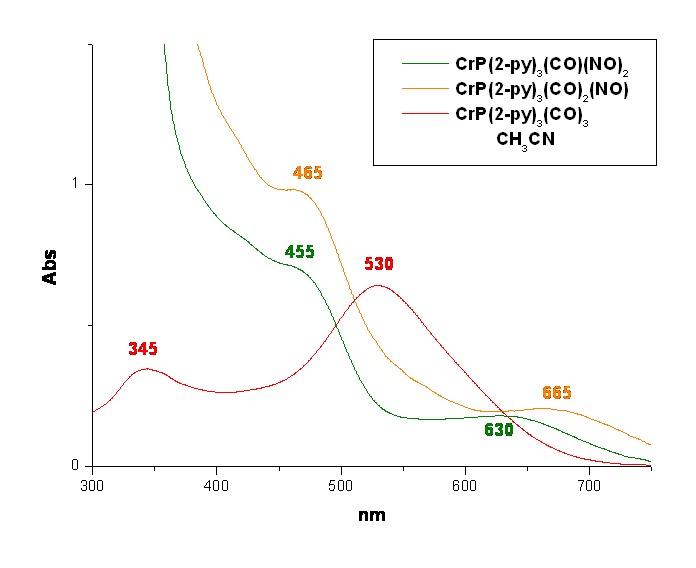
Experimental IR Spectra
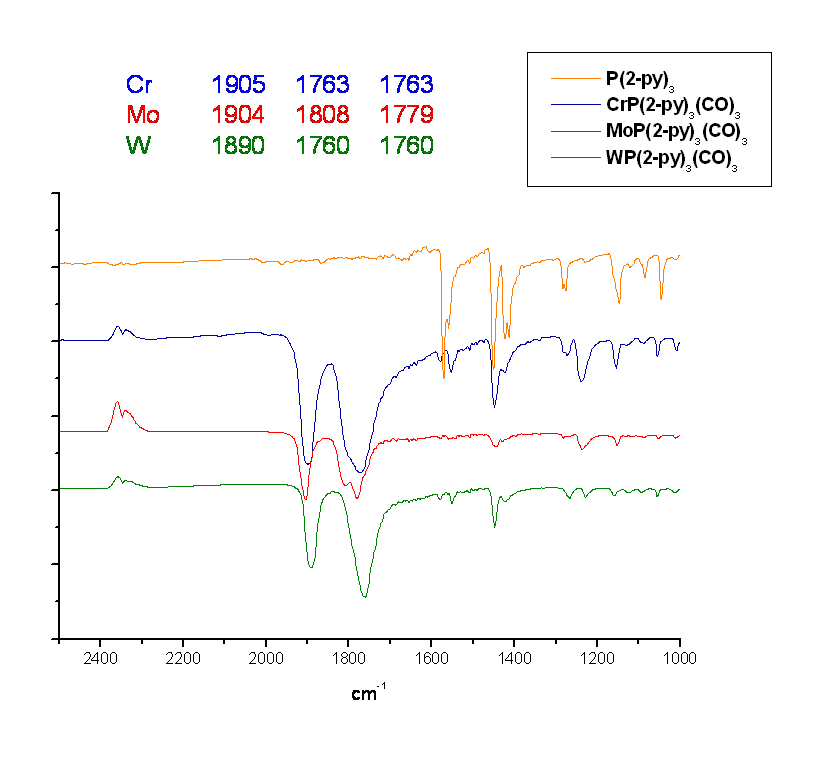
Calculated IR (B3LYP/6-31G*) :
2012 cm-1 (1554) CO symm. stretching
1950 cm-1 (1073) CO asymm stretching (2)
1604 cm-1 (32) pyridine C-C, C-N
1500 cm-1 (34) pyridine H rocking
1496 cm-1 (90) pyridine H rocking (2)
1466 cm-1 (23) pyridine H rocking
1315 cm-1 (49) pyridine H rocking
1023 cm-1 (36) pyridine breathing
Recommended Scaling Factor for B3LYP/6-31G* is 0.9614
(p. 305 in Cramer's book)
P(2-py)3Cr(CO)2(NO+)
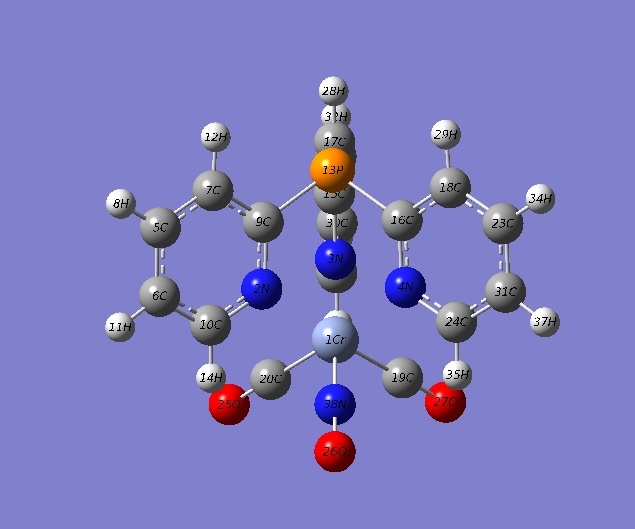
Structure
| B3LYP/3-21G* | B3LYP/6-31G* | |
| E(a.u.) | -2472.7456344 | -2485.3347621 |
| S-T gap | 46.2 kcal/mol | |
| P-C | 1.835 | 1.852 |
| N-Cr | 2.103, 2.153 (3N-Cr) | 2.159, 2.197 |
| Cr-C | 1.853 | 1.895 |
| Cr-N | 1.650 (Cr-38N) | 1.671 |
| C-O | 1.166 | 1.150 |
| N-O | 1.212 | 1.174 |
A TD(50-50) calculation shows that at the singlet structure, the lowest triplet state (3A') has an energy 0.90 eV above the singlet state. Unfortunately no low-lying triplet state is found.
Excited-State Energies (nm) and Oscillator Strengths
| TD B3LYP/3-21G* | ||
| 1 | 507.2 | 0.007 |
| 2 | 451.4 | 0.014 |
| 3 | 434.3 | 0.029 |
| 4 | 409.2 | 0.012 |
| 5 | 364.2 | 0.031 |
Triplet State Geometry (bent Cr-N-O)

Structure
| B3LYP/3-21G* | B3LYP/6-31G* | |
| E(a.u.) | -2472.7083543 | -2485.2925449 |
| S-T gap | 23.4 kcal/mol | 26.5 kcal/mol |
| P-C | 1.838 | 1.854 |
| N-Cr | 2.083, 2.119 (3N-Cr) | 2.142, 2.170 |
| Cr-C | 1.895 | 1.930 |
| Cr-N | 1.859 (Cr-38N) | 1.889 |
| C-O | 1.164 | 1.148 |
| N-O | 1.253 | 1.194 |
| A(Cr-N-O) | 127.1 | 131.3 |
A TD(50-50) calculation shows that at the triplet structure, the lowest triplet state (3A') has an energy 1.42 eV below the singlet state.
E(RPA) = -2485.32038649, which is now only 9 kcal/mol higher than the singlet energy at the optmized singlet structure, and is 10 kcal/mol lower than the triplet energy at the singlet structure. If the energy of this triplet state can be further optimized, it may have a chance to be the electronic ground state.
If we turn the NO down and keeps the Cs structure, a TD(50-50) calculation shows that the lowest triplet state (3A') has an energy 1.57 eV below the singlet state. E(RPA) = -2485.34102225, which is now 3.9 kcal/mol lower than the optimized singlet state. Since the ZPE of the triplet state ( 167.2 kcal/mol) is ~1.8 kcal/mol lower than that of the singlet state (169.0), the triplet is now 5.7 kcal/mol lower than the singlet state.
Excited-State Energies (nm) and Oscillator Strengths
| TD B3LYP/3-21G* | TD B3LYP/6-31G* | |||
| 1 | 722.9 | 0.002 | 796.9 | 0.010 |
| 2 | 690.3 | 0.011 | 688.6 | 0.001 |
| 3 | 595.1 | 0.020 | 656.6 | 0.001 |
| 4 | 537.3 | 0.002 | 504.8 | 0.013 |
| 5 | 508.5 | 0.002 | 492.4 | 0.003 |
| 6 | 488.1 | 0.009 | 475.1 | 0.003 |
| 7 | 461.9 | 0.017 | 466.8 | 0.014 |
| 8 | 449.6 | 0.007 | 433.6 | 0.008 |
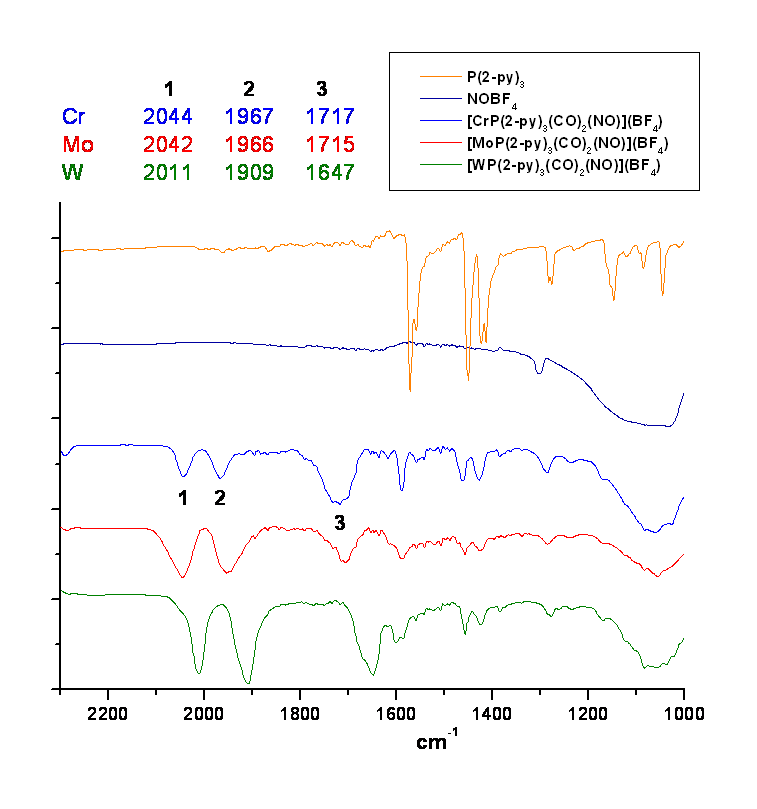
Predicted (B3LYP/6-31G*) IR spectra
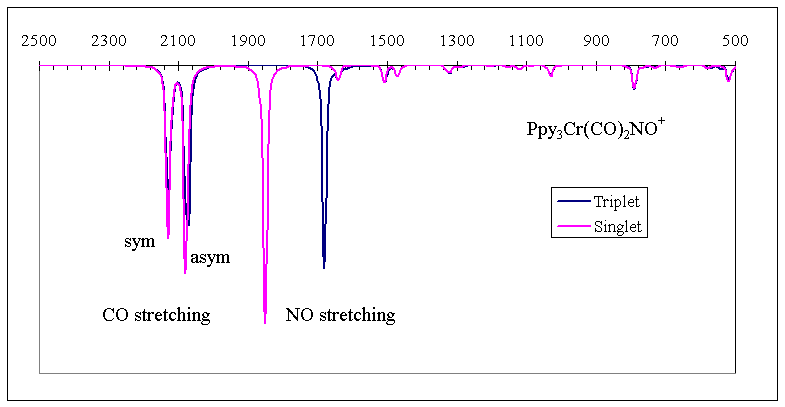
Triplet:
2127, 2075 CO stretching
1680 NO stretching
Singlet:
2128, 2078 CO stretching
1851 NO stretching
P(2-py)3Cr(CO)(NO+)2
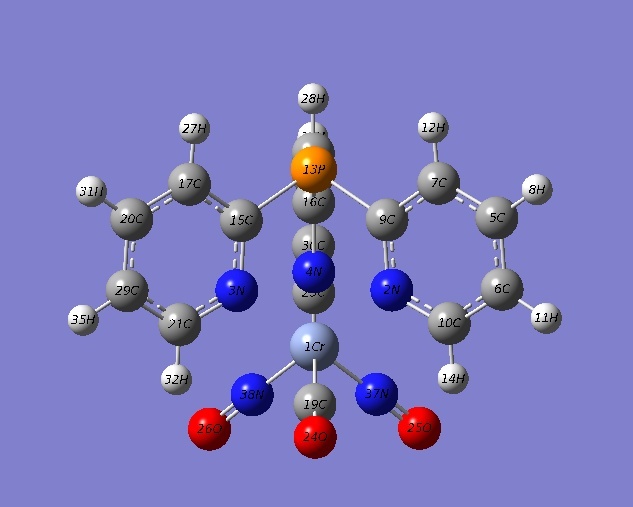
Structure
| B3LYP/3-21G* | B3LYP/6-31G* | B3LYP/6-311G* SP | B3LYP/6-311+G* SP | BLYP/6-31G* | |
| E(a.u.) | -2488.8939751 | -2501.5754842 | -2501.91037424 | -2501.92814666 | -2501.69359237 |
| S-T Gap | |||||
| P-C | 1.837 | 1.852 | |||
| N-Cr | 2.107, 2.065 (4N-Cr) | 2.147, 2.118 | |||
| Cr-C | 1.964 | 2.005 | |||
| Cr-N | 1.689(37N-Cr) | 1.716 | |||
| C-O | 1.147 | 1.133 | |||
| N-O | 1.181 | 1.148 |
B3LYP/6-31G*
Triplet SP at singlet B3LYP/6-31G* geom.(stable=opt): -2501.5137901 (A'')
S-T: 38.7 kcal/mol
However, a TD(50-50) calculation shows that at the singlet structure, there is a low-lying triplet state (3A') with a energy 0.93 eV or 21.4 kcal/mol lower than the singlet state. E(RPA) = -2501.60983405
Unfortunately, this state cannot be found with a simple triplet state calculation as mentioned above.
A similar calculation for P(2-py)3Mo(CO)(NO+)2 does not show a low-lying triplet state and the lowest triplet state is 1.75 eV higher in energy.
Excited-State Energies (nm) and Oscillator Strengths
| TD B3LYP/3-21G* | TD B3LYP/6-31G* | |||
| 1 | 563.7 | 0.0005 | 526.3 | 0.0005 |
| 2 | 399.7 | 0.0018 | 421.1 | 0.0006 |
| 3 | 395.1 | 0.0006 | 394.5 | 0.0030 |
| 4 | 393.0 | 0.0005 | 386.1 | 0.0010 |
| 5 | 381.7 | 0.0008 | 358.6 | 0.0017 |

Structure
| B3LYP/3-21G* | B3LYP/6-31G* | B3LYP/6-311G* | B3LYP/6-311+G* | BLYP/6-311G* | |
| E(a.u.) | -2488.8793906 | -2501.5572722 | -2501.89204458 | -2501.9103885 | -2501.64973299 |
| S-T gap | 9.2 kcal/mol | 11.4 kcal/mol | 11.5 kcal/mol | 11.1 kcal/mol | 27.5 kcal/mol |
| P-C | 1.838 (P-9C), 1.843 | 1.852, 1.857 | |||
| N-Cr | 2.086 (Cr-2N) 2.050 (Cr-3N) 2.033 (Cr-4N) |
2.139 2.093 2.081 |
|||
| Cr-C | 2.111 | 2.131 | |||
| Cr-N | 1.988 (Cr-37N) 1.748 (Cr-38N) |
2.070 1.748 |
|||
| C-O | 1.143 | 1.130 | |||
| N-O | 1.194 (37N-25O) 2.204 (38N-26O) |
1.154 1.165 |
|||
| A(Cr-N-O) | 135.6 | 134.9 |
A TD(50-50) calculation at the above B3LYP/6-31+G* structure finds a low-lying triplet state that is 1.42 eV below the singlet. E(RPA) = -2501.56916355 and it is 4.0 kcal/mol lower than that of the optimized singlet state. Interestingly, the energy is significantly higher than the triplet energy calculated at the singlet structure. The geom. with NO pointing down needs to be checked
A TD(50-50) calculation at the above B3LYP/6-31+G* structure with NO pointing down finds a low-lying triplet state that is 1.79 eV below the singlet. E(RPA) = -2501.59087848 and it is 9.7 kcal/mol lower than that of the optimized singlet state.
P(py)3Cr(NO)2 (2+)
B3LYP/6-31G* singlet OPT: -2388.22533
B3LYP/6-31G* triplet OPT: -2388.22186
S-T: 2.2 kcal/mol
Right now it seems that using TD(50-50) can make prediction that is consistent with experiments.
However, we need to check if this is an artifact of using different basis set. So we also make calculation using SDD for Cr.
P(2-py)3Cr(CO)2NO+ (using B3LYP/6-31G* geom.)
singlet energy at singlet structure : -1527.92751580 (0.0 kcal/mol)
triplet energy at triplet structure: -1527.91660998 (6.8 kcal/mol)
triplet energy with NO down: -1527.93805818 (-6.6 kcal/mol)
P(2-py)3Cr(CO)(NO+)2 (using B3LYP/6-31G* geom.)
singlet energy at singlet structure: -1544.16366672 (0.0 kcal/mol)
triplet energy at singlet structure: -1544.20877941 (-28.3 kcal/mol)
triplet energy at triplet structure: -1544.16167 (1.3 kcal/mol)
So, the calculation with SDD for Cr seems to be consistent with the 6-31G* results.
Excited-State Energies (nm) and Oscillator Strengths
| TD B3LYP/3-21G* | TD B3LYP/6-31G* | |||
| 1 | 679.0 | 0.003 | 596.7 | 0.008 |
| 2 | 637.4 | 0.008 | 481.3 | 0.002 |
| 3 | 470.5 | 0.002 | 470.4 | 0.002 |
| 4 | 456.7 | 0.005 | 453.2 | 0.004 |
| 5 | 441.1 | 0.002 | 447.4 | 0.013 |
| 6 | 414.2 | 0.003 | 434.8 | 0.001 |
| 7 | 410.4 | 0.010 | 425.6 | 0.002 |
| 8 | 365.2 | 0.008 | 396.6 | 0.004 |
Experimental IR Spectra
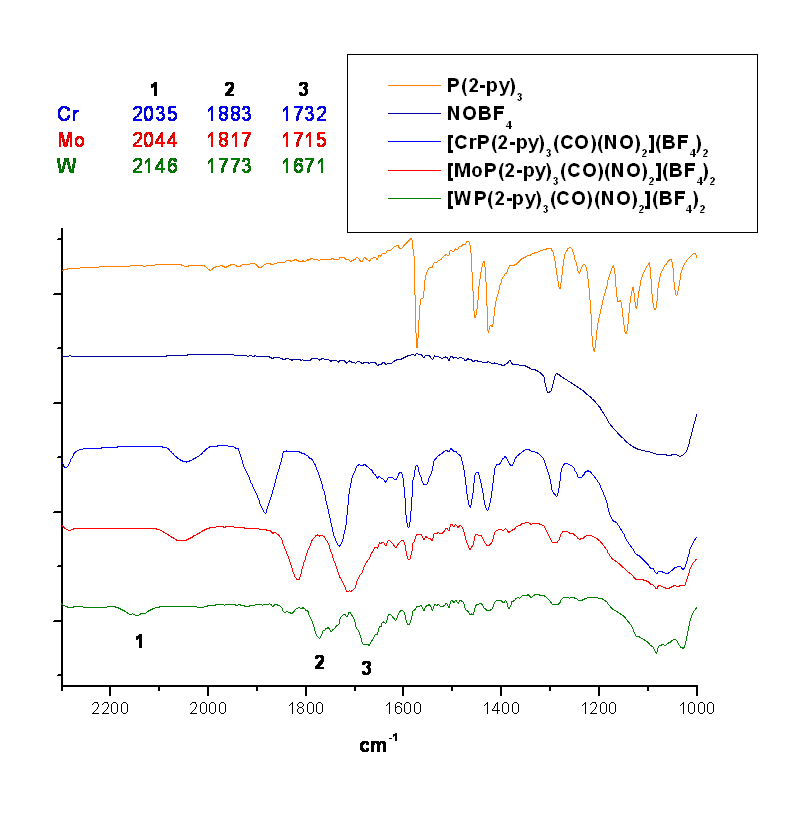
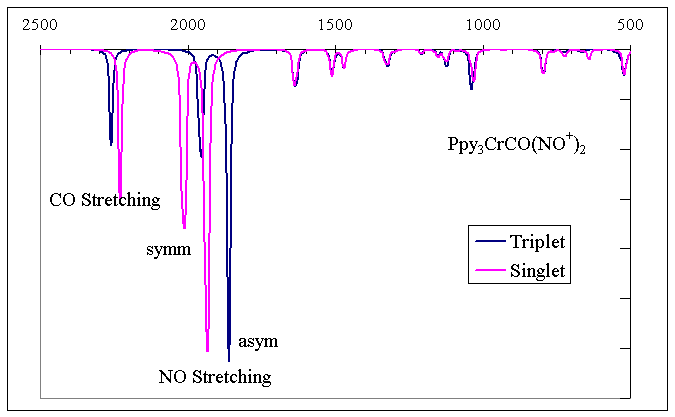
Triplet:
2259 CO stretching
1954, 1862 NO stretching
1633-1639
1472-1509
1320-1328 pyridine H in-plane bending
1123
1035-1045 Pyridine breathing
795 Pyridine H out-of-plane bending
Singlet:
2229 CO stretching
2015, 1934 NO stretching
| B3LYP/3-21G* | B3LYP/6-31G* | |
| E(a.u.) | -5376.0215894 | -1492.7677958 |
| P-C | 1.836 | 1.853 |
| N-Mo | 2.262 | 2.299 |
| Mo-C | 1.974 | 1.971 |
| C-O | 1.185 | 1.172 |
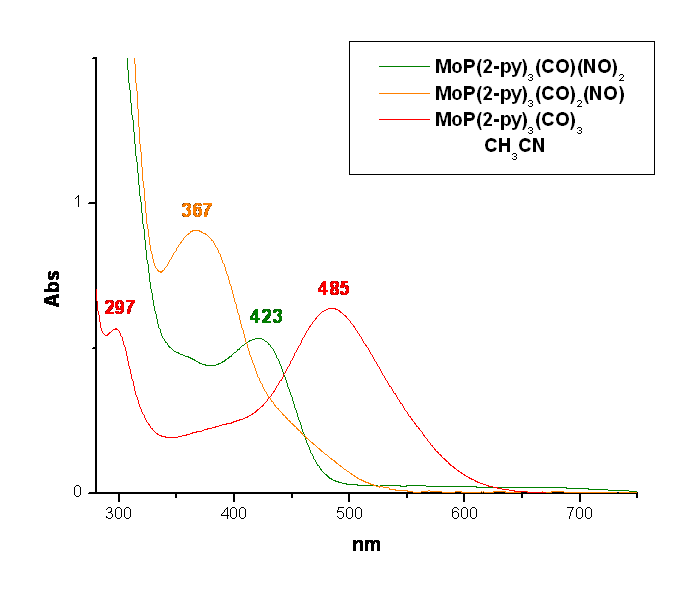
Excited-State Energies (nm) and Oscillator Strengths
| TD B3LYP/3-21G* | TD B3LYP/6-31G* | |||
| 1 | 700.7 (2) | 0.024 | 676.5 (2) | 0.023 |
| 2 | 516.0 (2) | 0.050 | 521.6 | 0.164 |
| 3 | 511.5 | 0.186 | 503.4 (2) | 0.043 |
| 4 | 485.3 (2) | 0.013 | 477.9 (2) | 0.011 |
| 5 | 481.8 | 0.010 | 304.2 (2) | 0.028 |
Calculated (B3LYP/6-31G* IR Spectra)
C-O 2005, 1934 (2) cm-1
P(2-py)3Mo(CO)2(NO+)
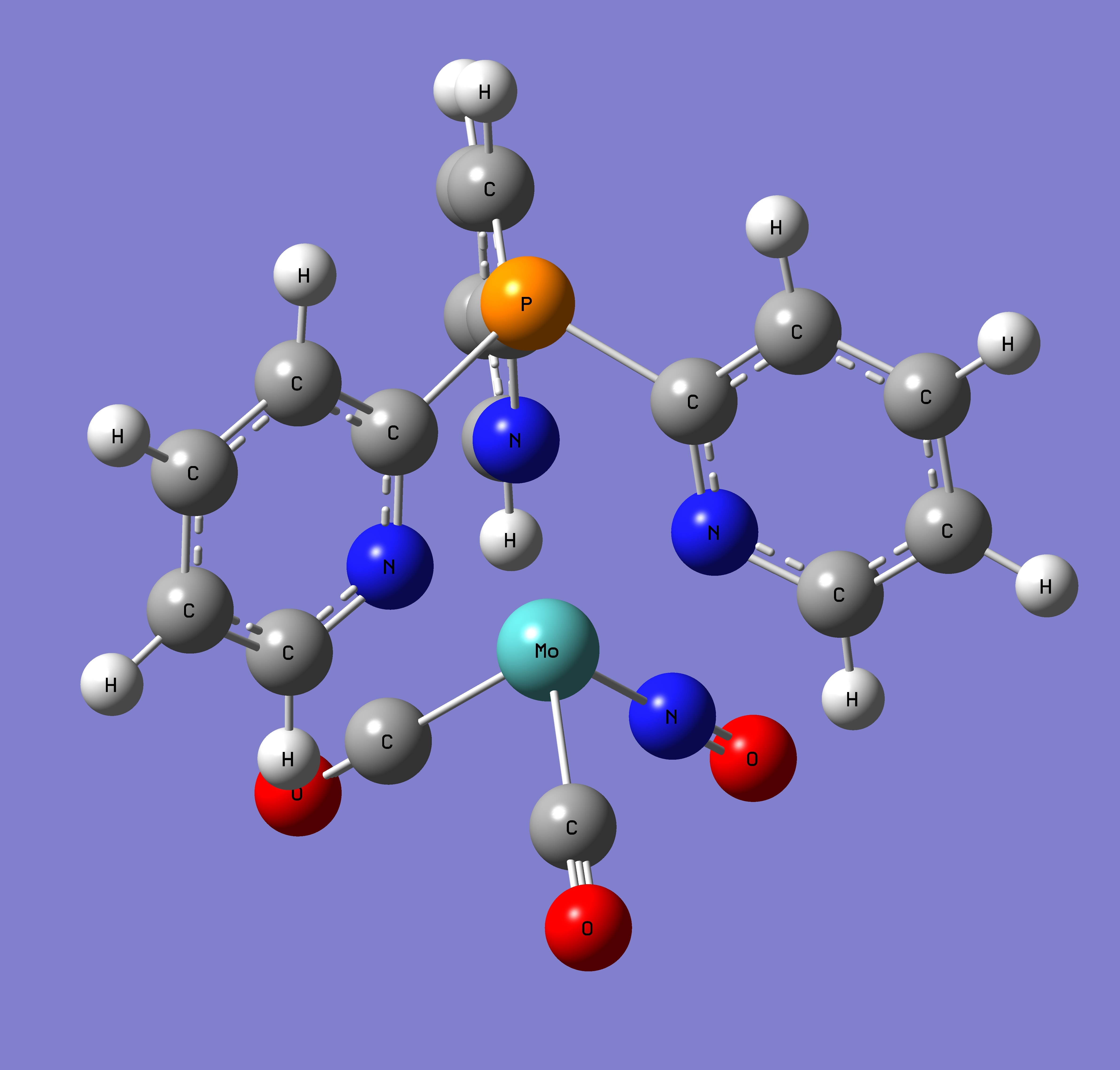
Structure
| B3LYP/3-21G* | B3LYP/6-31G* | |
| E(a.u.) | -5392.3544707 | -1509.195122 |
| P-C | 1.842 | 1.856 |
| N-Mo | 2.254, 2.287 (3N-Mo) | 2.288, 2.308 |
| Mo-C | 2.031 | 2.026 |
| Mo-N | 1.821 | 1.818 |
| C-O | 1.167 | 1.153 |
| N-O | 1.207 | 1.177 |
Excited-State Energies (nm) and Oscillator Strengths
| TD B3LYP/3-21G* | TD B3LYP/6-31G* | |||
| 1 | 482.3 | 0.007 | 464.3 | 0.008 |
| 2 | 432.2 | 0.002 | 421.6 | 0.009 |
| 3 | 414.7 | 0.044 | 405.1 | 0.033 |
| 4 | 387.8 | 0.029 | 374.8 | 0.027 |
| 5 | 362.0 | 0.004 | 343.5 | 0.015 |
| 342.0 | 0.025 | |||
| 323.1 | 0.024 | |||
| 322.9 | 0.013 |
Calculated (B3LYP/6-31G* IR Spectra)
C-O 2110, 2051 cm-1
N-O 1823 cm-1
Triplet Structure
| B3LYP/6-31G* | |
| E(a.u.) | -1509.13160803 |
| S-T gap | 39.9 kcal/mol |
| P-C | 1.858 |
| N-Mo | 2.274 |
| Mo-C | 2.030 |
| Mo-NO | 2.025 |
| C-O | 1.153 |
| N-O | 1.194 |
| A(Mo-N-O) | 130.8 |
A TD(50-50) calculation at the above structure finds a low-lying triplet state that is 1.08 eV below the singlet. E(RPA) = -1509.16891 and it is 16.4 kcal/mol higher than that of the optimized singlet state. This implies for P(2-py)3Mo(CO)2NO+, the S-T gap might also be small. The geom. with NO pointing down needs to be checked.
A TD(50-50) calculation using the above structure with NO pointing down finds a triplet state at is 1.08 eV below the singlet. E(RPA) = -1509.17585756 and it is 12.1 kcal/mol higher than that of the optimized singlet state.
P(2-py)3Mo(CO)(NO+)2
for 6-31G*, Mo: SDD
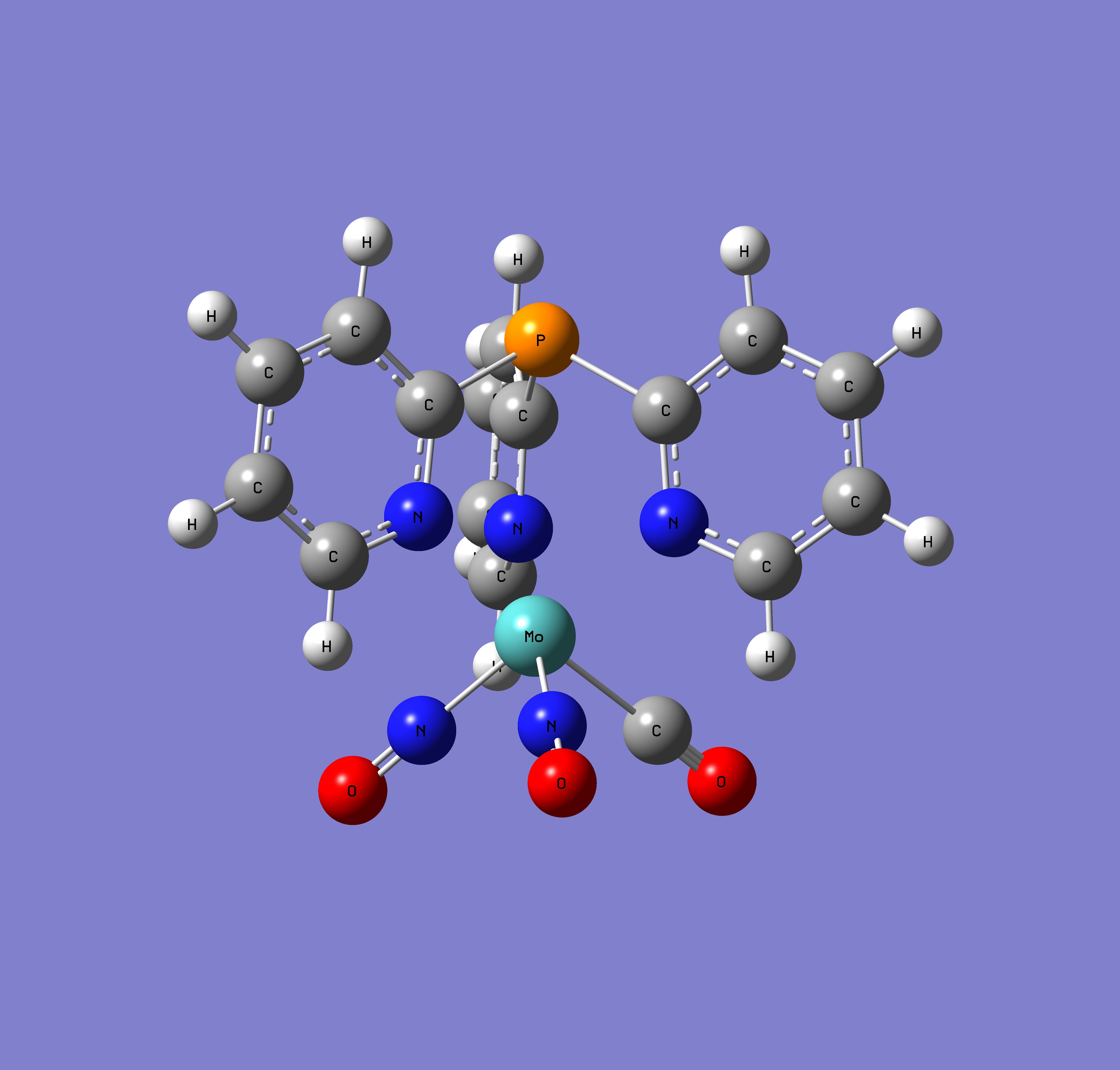
Singlet Structure
| B3LYP/3-21G* | B3LYP/6-31G* | |
| E(a.u.) | -5408.4977614 | -1525.4378026 |
| P-C | 1.843 | 1.857 |
| N-Mo | 2.236, 2.202 (4N-Cr) | 2.257, 2.237 |
| Mo-C | 2.160 | 2.138 |
| Mo-N | 1.867(37N-Cr) | 1.867 |
| C-O | 1.149 | 1.135 |
| N-O | 1.181 | 1.153 |
Excited-State Energies (nm) and Oscillator Strengths
| TD B3LYP/3-21G* | TD B3LYP/6-31G* | |||
| 1 | 602.9 | 0.0007 | 565.6 | 0.0009 |
| 2 | 552.9 | 0.0001 | 525.2 | 0.0001 |
| 3 | 442.0 | 0.0003 | 427.0 | 0.0007 |
| 4 | 429.5 | 0.0001 | 420.1 | 0.0004 |
| 5 | 417.6 | 0.0003 | 383.2 | 0.0014 |
| 6 | 382.3 | 0.0031 | 359.0 | 0.0029 |
| 348.7 | 0.0012 | |||
| 343.7 | 0.0015 |
Calculated (B3LYP/6-31G* IR Spectra)
C-O 2210 cm-1
N-O 1964 (symm), 1895 cm-1 (asymm)
B3LYP/6-31G*
Triplet SP at singlet B3LYP/6-31G* geom.(stable=opt): -1525.37325018 (A')
S-T: 40.5 kcal/mol
Triplet Structure
| B3LYP/6-31G* | B3LYP/6-311G* | B3LYP/6-311+G* | |
| E(a.u.) | -1525.39084 | ||
| S-T gap | 29.5 kcal/mol | ||
| P-C | 1.862, 1.856 | ||
| N-Mo | 2.206 2.207 2.268 |
||
| Mo-C | 2.169 | ||
| Mo-NO | 2.179* 1.835 |
||
| C-O | 1.135 | ||
| N-O | 1.159* 1.163 |
||
| A(Cr-N-O) | 134.5* |
*for the bent NO
A TD(50-50) calculation at the above structure finds a low-lying triplet state that is 1.12 eV below the singlet. E(RPA) = -1525.42132 and it is 10.3 kcal/mol higher than that of the optimized singlet state. This implies for P(2-py)3Mo(CO)(NO)22+, the S-T gap might also be small. The geom. with NO pointing down needs to be checked.
| B3LYP/3-21G* | B3LYP/6-31G* | |
| E(a.u.) | -1484.7972365 | -1491.660976 |
| P-C | 1.831 | 1.850 |
| N-W | 2.218 | 2.287 |
| W-C | 1.987 | 1.984 |
| C-O | 1.188 | 1.174 |

Excited-State Energies (nm) and Oscillator Strengths
| TD B3LYP/3-21G* | TD B3LYP/6-31G* | |||
| 1 | 723.7 (2) | 0.022 | 711.3 (2) | 0.023 |
| 2 | 524.6 (2) | 0.076 | 521.6 (2) | 0.054 |
| 3 | 490.3 | 0.206 | 521.4 | 0.188 |
| 4 | 488.0 (2) | 0.016 | 490.4 (2) | 0.012 |
| 5 | 484.2 | 0.036 | 398.6 (2) | 0.007 |
| 6 | 394.3 (2) | 0.011 | 299.9 (2) | 0.029 |
Calculated (B3LYP/6-31G* IR Spectra)
C-O 2000, 1930 (2) cm-1
| B3LYP/3-21G* | B3LYP/6-31G* | |
| E(a.u.) | -1501.1340921 | -1508.0922016 |
| P-C | 1.839 (2), 1.842 | 1.855, 1.858 |
| N-W | 2.231, 2.247 (3N-Mo) | 2.288, 2.308 |
| W-C | 2.018 | 2.027 |
| W-N | 1.836 | 1.833 |
| C-O | 1.172 | 1.156 |
| N-O | 1.217 | 1.182 |
Excited-State Energies (nm) and Oscillator Strengths
| TD B3LYP/3-21G* | TD B3LYP/6-31G* | |||
| 1 | 556.1 | 0.009 | 502.9 | 0.008 |
| 2 | 470.6 | 0.043 | 443.6 | 0.039 |
| 3 | 442.0 | 0.005 | 423.6 | 0.005 |
| 4 | 426.5 | 0.045 | 394.9 | 0.041 |
| 5 | 399.7 | 0.049 | 370.6 | 0.026 |
| 6 | 389.5 | 0.032 | 366.6 | 0.030 |
| 7 | 366.0 | 0.008 | 334.1 | 0.027 |
| 8 | 348.5 | 0.031 | 315.4 | 0.017 |
| 9 | 339.7 | 0.023 |
Calculated (B3LYP/6-31G* IR Spectra)
C-O 2098 (symm), 2036 cm-1
N-O 1806 cm-1
Triplet Structure
| B3LYP/6-31G* | |
| E(a.u.) | -1508.0242165 |
| S-T gap | 42.2 kcal/mol |
| P-C | 1.857 |
| N-W | 2.267,2.274 |
| W-C | 2.025 |
| W-NO | 2.021 |
| C-O | 1.157 |
| N-O | 1.200 |
| A(W-N-O) | 130.7 |
A TD(50-50) calculation at the above structure finds a low-lying triplet state that is 1.05 eV below the singlet. E(RPA) = -1508.06770506 and it is 15.4 kcal/mol higher than that of the optimized singlet state. This implies for P(2-py)3W(CO)2NO+, the S-T gap might also be small. The geom. with NO pointing down needs to be checked.
A TD(50-50) calculation using the above structure with NO pointing down finds a triplet state at is 1.03 eV below the singlet. E(RPA) = -1508.06608385 and it is 16.4 kcal/mol higher than that of the optimized singlet state.
P(2-py)3W(CO)(NO+)2
Singlet Structure
| B3LYP/3-21G* | B3LYP/6-31G* | |
| E(a.u.) | -1517.7748331 | -1524.3419815 |
| P-C | 1.835 (2), 1.826 | 1.857 |
| N-W | 2.200, 2.189 (4N-Cr) | 2.257, 2.240 |
| W-C | 2.021 | 2.126 |
| W-N | 1.896 (37N-W) | 1.875 |
| C-O | 1.175 | 1.137 |
| N-O | 1.263 | 1.159 |
Excited-State Energies (nm) and Oscillator Strengths
| TD B3LYP/3-21G* | TD B3LYP/6-31G* | |||
| 1 | 763.1 | 0.007 | 580.1 | 0.001 |
| 2 | 759.1 | 0.012 | 422.9 | 0.001 |
| 3 | 524.2 | 0.018 | 360.6 | 0.003 |
| 4 | 518.8 | 0.014 | 356.2 | 0.003 |
| 5 | 497.6 | 0.009 | 348.1 | 0.002 |
| 6 | 440.9 | 0.007 | 340.9 | 0.003 |
| 7 | 436.5 | 0.117 | 348.7 | 0.0012 |
| 8 | 397.8 | 0.015 | 343.7 | 0.0015 |
| 9 | 392.2 | 0.045 | ||
| 10 | 371.2 | 0.011 | ||
| 11 | 368.6 | 0.009 |
Calculated (B3LYP/6-31G* IR Spectra)
C-O 2197 cm-1
N-O 1940 (symm), 1876 cm-1 (asymm)
Triplet Struicture
| B3LYP/6-31G* | B3LYP/6-311G* | B3LYP/6-311+G* | |
| E(a.u.) | -1524.28973 | ||
| S-T gap | 32.8 kcal/mol | ||
| P-C | 1.860, 1.854 | ||
| N-W | 2.208 2.213 2.276 |
||
| W-C | 2.143 | ||
| W-NO | 2.093* 1.841 |
||
| C-O | 1.137 | ||
| N-O | 1.170* 1.168 |
||
| A(W-N-O) | 140.1* |
A TD(50-50) calculation at the above structure finds a low-lying triplet state that is 0.78 eV below the singlet. E(RPA) = -1542.32419 and it is 11.2 kcal/mol higher than that of the optimized singlet state. This implies for P(2-py)3W(CO)(NO)22+, the S-T gap might also be small. The geom. with NO pointing down needs to be checked.

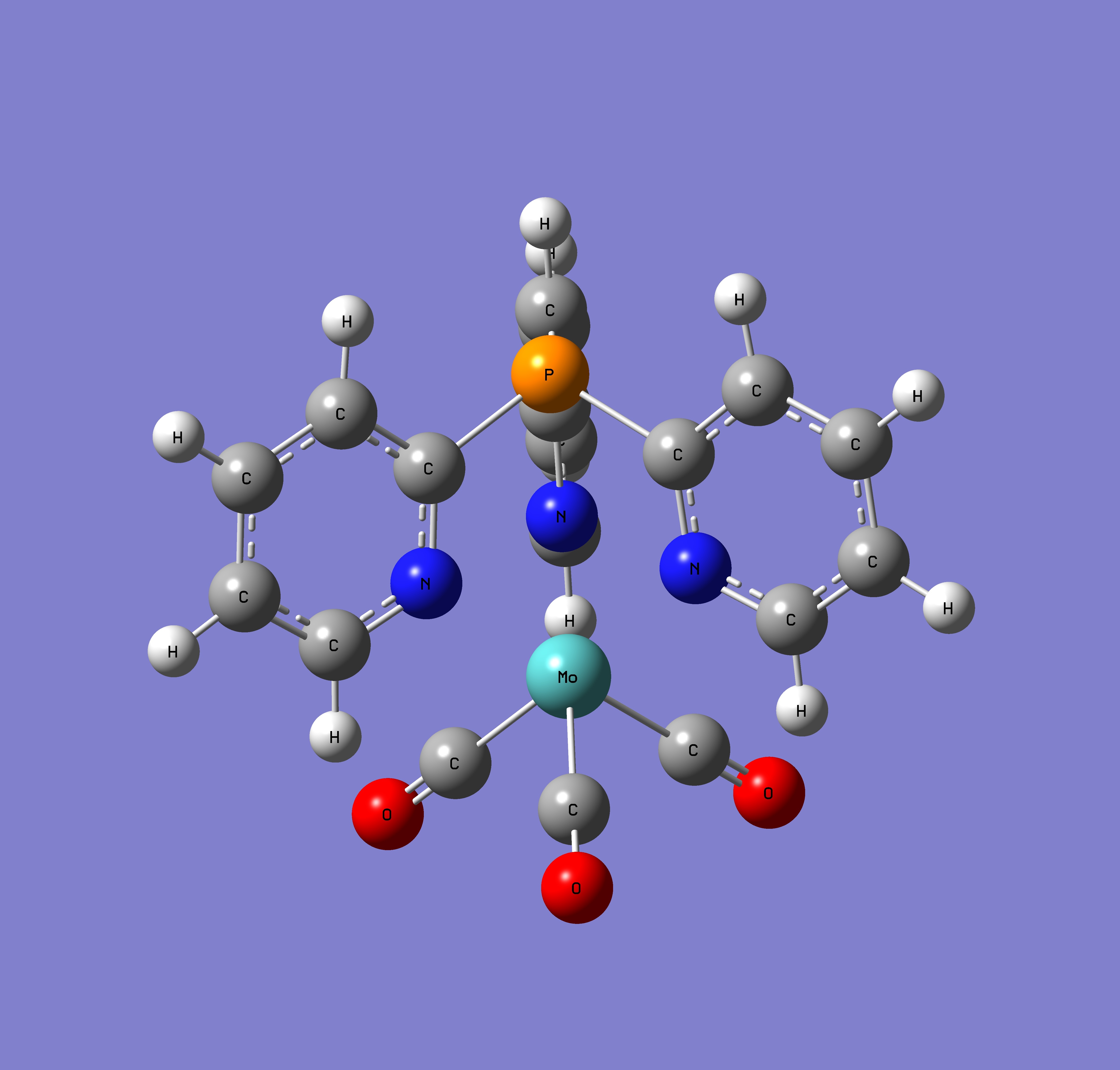
3.jpg)